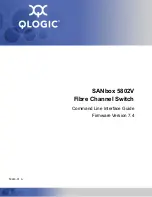
For more information visit: www.eaton.com
IIB01602019E
Instructional Booklet
Page
10
Effective: March 2010
O&M Manual for the Eaton ATC-100
Automatic Transfer Switch Controller
2.3.1 Programming Jumpers
The ATC-100 is programmable via the jumpers on the back of the
unit. The jumper selections are discussed in Section 5, Program-
ming.
2.3.2 Reset Pushbutton
The ATC-100 has a Reset pushbutton in the top right corner to
reset the following alarm conditions:
•
“Utility Connected” LED is blinking;
•
“Generator Connected” LED is blinking; and
•
“Generator Available” LED is blinking.
See Section 5.2, ATC-100 Troubleshooting for further information
on these alarm conditions.
Note:
Pressing the Reset pushbutton will also clear the Generator Test pro-
gramming. It will be necessary to set up the Generator Test again after
pressing the Reset pushbutton.
2.4 Control Inputs
The ATC-100 has two individual control input signals that are
used to sense transfer switch position. The inputs require and
external contact closure to the DC_Output pin (J4, Pin1). The
DC_Output pin is connected internally to the unregulated DC sup-
ply (26 V) and appropriate current-limiting to provide a nominal
current of 10 mA per channel.
2.4.1 Control Input Descriptions
The Control Input “State” definitions are as follows.
Connected -
When the input is shorted by an external contact or
connection.
Unconnected -
When the input is NOT shorted by an external con-
tact or connection.
The Control Input operations are defined as follows.
Utility Closed
When this input (J4, Pin 2) is in the “Connected” state, it indi-
cates to the ATC-100 that the utility switching device is closed.
When this input is in the “Unconnected” state, it indicates to the
ATC-100 that the utility switching device is open. This input is
typically wired to the utility device auxiliary contact that is closed
when the utility switching device is closed.
Generator Closed
When this input (J4, Pin 3) is in the “Connected” state, it indi-
cates to the ATC-100 that the generator switching device is
closed. When this input is in the “Unconnected” state, it indicates
to the ATC-100 that the generator switching device is open. This
input is typically wired to the generator device auxiliary contact
that is closed when the generator switching device is closed.
2.5 Output Relays
The primary control outputs of the ATC-100 are dry relay con-
tacts. These relays are comprised of one latching “Form C” relay
to provide the generator start contacts, and two conventional coil
“Form C” relays (that implement only the Form A contact) neces-
sary to complete the electrical control function. Since the outputs
were tested per the UL 1008 Dielectric Test and the IEC 947-6
Dielectric Test, the dielectric rating for each output is a minimum
of 1500 Vac.
The Output Relay functions are divided into two categories:
•
Customer Connections and
•
Transfer Operation Connections.
Figure 4. J-4 and J-5 Connector Connections.
2.5.1 Customer Connections
Generator Start Relay
The generator start relay is a latching relay with Form C contacts
of silver alloy with gold flashing for closure of the generator start
circuit.
The Form C contact is implemented with the Common Pin (J-5,
Pin 2), the Normally Open Pin (J-5, Pin 1) and the Normally Closed
Pin (J-5, Pin 3) (see Figure 4). The generator start relay contacts
are rated for 5 A, 1/6 HP @ 250 Vac. The DC rating is 5 A @ 30
Vdc with a 150 W maximum load.
Note:
Note:The ATC-100 MUST BE properly grounded at J-4, Pin 8 for
proper operation.
2.5.2 Transfer Operations Connections
The K1 and K2 relays are factory wired to operate the transfer
switch. The relay contacts for each are rated for 10 A,
1/3 HP @ 250 Vac. The DC rating is 10 A @ 30 Vdc.
Output Relay K1
This relay is used to control transfer switch position. Only the
Form A contact is available for connection.
This output is used to close the utility switching device. The K1
relay momentarily energizes until the ATC-100 senses that the
utility switching device is closed, then K1 de-energizes. The K1
outputs are the Common Pin (J-4, Pin 4) and Normally Open Pin
(J-4, Pin 5) (see Figure 4).
CONNECTOR J4
CONNECTOR J5






































